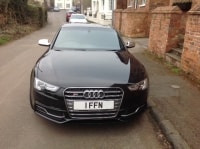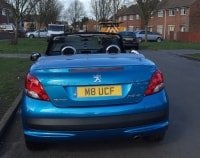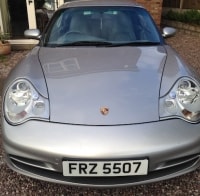Private Number Plate Rules: The DVLA Guidelines for Number Plates
What better way is there of making a statement with your vehicle, than getting some personalised plates?
They are a guaranteed way to make your car stand out from the crowd and add a really individual touch. But are you unsure of the various private number plate rules?
You may be aware in the back of your mind that private number plates are regulated by an organisation called the DVLA, but you might not know exactly how.
Well, don't worry. If you follow this handy guide, you can enjoy your private number plates while staying firmly on the right side of the law.
Displaying Number Plates
Firstly, there are a number of rules about displaying all number plates, not just private ones, on vehicles.
The Driver and Vehicle Licensing Agency (DVLA) issues the rules and puts them in place to ensure there is some consistency across all number plates on the road. This makes it safer and easier for the police and other emergency services, and can also cut down on car theft crimes.
The DVLA states that UK number plates should:
- Be made from a reflective material
- Display black characters on a white background (front plate)
- Display black characters on a yellow background (rear plate)
- Not have a background pattern
So long as your plate follows these rules then it will be legal.
The Format of Number Plates
All number plates must follow the same display format. The format is two letters, two numbers, a space, and three further letters.
The first two letters are the DVLA memory tag which is specific to a city or location. For instance, "BD" is for Birmingham.
The two numbers indicate the age of the vehicle, and changes twice each year. For example, 16 would be May 2006 and 56 would be September 2006. The last three letters are random.
It's an offence to alter or rearrange the numbers and letters on a number plate to form words, or in a way that makes it difficult to read the registration number.
For example, you should not use screws or bolts to change any of the letters or numbers. Anyone with a number plate that does not display the registration number correctly could be fined up to £1,000.
Obtaining a Private Number Plate
So those are the basic rules about displaying number plates. But how do you go about choosing a private number plate and stay within these rules?
Firstly, you can only get a number plate made by a registered number plate supplier.
The number plate supplier needs to see some proof of ID and also proof that you're entitled to use that particular number plate. Then, you can transfer the number plate over to your vehicle.
You can use the following to confirm your name and address:
- Driving licence
- Utility, council tax or rates bill from the last six months
- Bank or building society statement from the last six months
- National identity card
You can find the DVLA forms you need to transfer the number plate to your name here on our website.
Private Number Plate Rules
As of 1st September 2001, all new number plates must display the new standard font. This is supposed to make number plates clearer and easier to remember.
Number plates fitted before 1st September 2001 need not be changed, provided the character font used is similar to the new font. Characters on a number plate can be 3D if they're of the mandatory font.
Number plates must be replaced if they're customised with:
- Stylised letters such as italics
- Number plate fixing bolts that alter the appearance of the letters
Also, the letters and numbers (characters) on number plates bought since 1 September 2001 need to meet the following number plate spacing standards:
- Characters must be 79mm tall
- Characters (except the number 1 or letter I) must be 50mm wide
- The character stroke (the thickness of the black print) must be 14mm
- The space between characters must be 11mm
- The space between the age identifier and the random letters must be 33mm
- The margins at the top, bottom and side of the plate must be 11mm
- Vertical space between the age identifier and the random letters must be 19mm
These rules just make sure that all number plates look the same and are easy to read. Any accredited reg plate supplier will make sure to abide by these regulations.
Eligibility
There are also some rules about which characters you can use. These are as follows:
- Assign a number starting with 'Q' or 'NIQ'
- Put a private number on a 'Q' registered vehicle
- Use a private number that makes a vehicle look newer than it is -- for example, an '07' registration number on a 2003 registered vehicle
So, basically, if you stick to the standard format and avoid these few characters, you'll be good to go with your private number plate.
Some Cool Effects That Are Allowed
Some of these rules might sound quite strict and like they do not allow for any room for creativity. Well, that's not entirely true.
There is no reason why your private number plate shouldn't look great and stand out. So here are some things you are allowed to do when you put a registration on your car:
Borders
So long as they are non-reflective and do not interfere with the characters or numbers on the reg plate, you can put a border around your number plate.
Text
You can no longer use italics or different coloured text on your plate but there are still things you can do. 3D text can look really eye-catching and is legal.
Flags
You're legally entitled to display one of the following flags on your number plate:
- Union Jack Flag
- Cross of St George (English flag)
- Cross of St Andrew -- also known as the Saltire (Scottish flag)
- Red Dragon of Wales
However, if you display any of the flags above, you still need to display a 'GB' sticker if driving your vehicle abroad. But if you display the Euro symbol on your number plate, you won't need a separate GB sticker when travelling in the European Union.
Finding The Number Plate You Want
So those are the various private number plate rules. Now you know how to stay on the right side of the law, you can have fun finding the right reg plate for you.
And don't forget, if you have any further questions about how to put a registration plate on your vehicle you can contact us and we'll be happy to help.

















